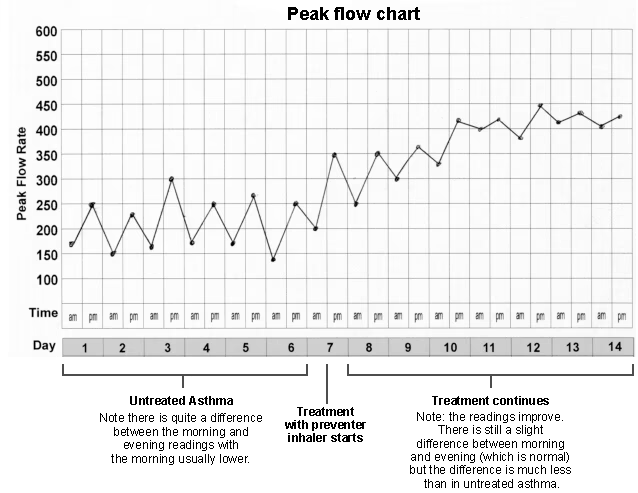Peak flow meter for asthma
Peer reviewed by Dr Colin Tidy, MRCGPLast updated by Dr Toni HazellLast updated 13 Jun 2022
Meets Patient’s editorial guidelines
In this series:AsthmaAsthma inhalers
This leaflet provides information about the peak flow meter which is used by some people with asthma.
In this article:
Continue reading below
What is a peak flow meter?
A peak flow meter is a small device that you blow into. It measures the fastest rate of air (airflow) that you can blow out of your lungs. It records airflow in litres per minute(L/min) and provides you with a score, which is called peak expiratory flow rate (PEFR). Your doctor may prescribe a peak flow meter for you if you have asthma. There are different brands of peak flow meter. They all do the same job.
How to use a peak flow meter
Your doctor, nurse or other healthcare professional will show you how to take a peak flow test. It is important to do this correctly; otherwise, the readings can be misleading. Briefly, you must put the marker to zero, take a deep breath, close your lips around the mouthpiece, then blow air out of your lungs as fast as you can into the device. Note the reading. The further reading section has a link to an Asthma UK website which has a video showing how to use a peak flow meter.
When checking your peak flow score, you should do three blows, one after the other. The 'best of three' is the reading to record. However, when you do three blows straight after each other, the readings should all be about the same. If they are not, you may not be blowing into the device correctly. A common error is to not to blow as hard as you can. Another common error is to not put your lips right round the mouthpiece to make sure that all the air you blow out goes through the device.
Continue reading below
What is a normal peak flow reading?
Normal peak flow readings vary, depending on your age, size, and sex. The range of normal peak flow readings is published on a chart, and doctors and nurses refer to the chart when they check your peak flow reading.
Normally, in healthy people, peak flow readings vary slightly from time to time. The reading is often slightly higher in the evening compared with the morning.
What are peak flow meters used for?
To help diagnose asthma
If you have untreated asthma:
Your peak flow readings will usually be low. No matter how strong you are, if your airways are narrowed, your peak flow will be lower than expected for your age, size, and sex.
Your peak flow readings will tend to vary quite a lot. Typically, the readings are lower in the morning compared with the evening. This difference is much greater in people with untreated asthma than the normal small variation seen in most people.
Sometimes a doctor or nurse will give you a chart (like the one below), and ask you to keep a record of your peak flow readings for a week or so. You will normally be asked to take a 'best of three' peak flow reading each morning and evening. This information can be used to inform your asthma action plan and help doctors make decisions to alleviate asthma symptoms or prevent asthma attacks.
Sometimes a peak flow reading is done before and after you take a dose of asthma medicine to open up your airways. If the treatment causes a large improvement in your reading, this too is typical of asthma.
To monitor treatment
Measuring your peak flow readings can help assess how well treatment is working. Peak flow readings improve if narrowed airways open up with treatment.
Below is an example of a two-week diary of peak flow readings done by a child who has quite bad asthma.
Peak flow graph

Further reading and references
- Global Initiative for Asthma (GINA)
- British guideline on the management of asthma; Scottish Intercollegiate Guidelines Network (SIGN), British Thoracic Society (BTS), NHS Scotland (2003 - revised July 2019)
- Asthma; NICE CKS, April 2022 (UK access only)
- Peak flow; Asthma UK, 2020
Article History
The information on this page is written and peer reviewed by qualified clinicians.
Next review due: 12 Jun 2027
13 Jun 2022 | Latest version

Feeling unwell?
Assess your symptoms online for free